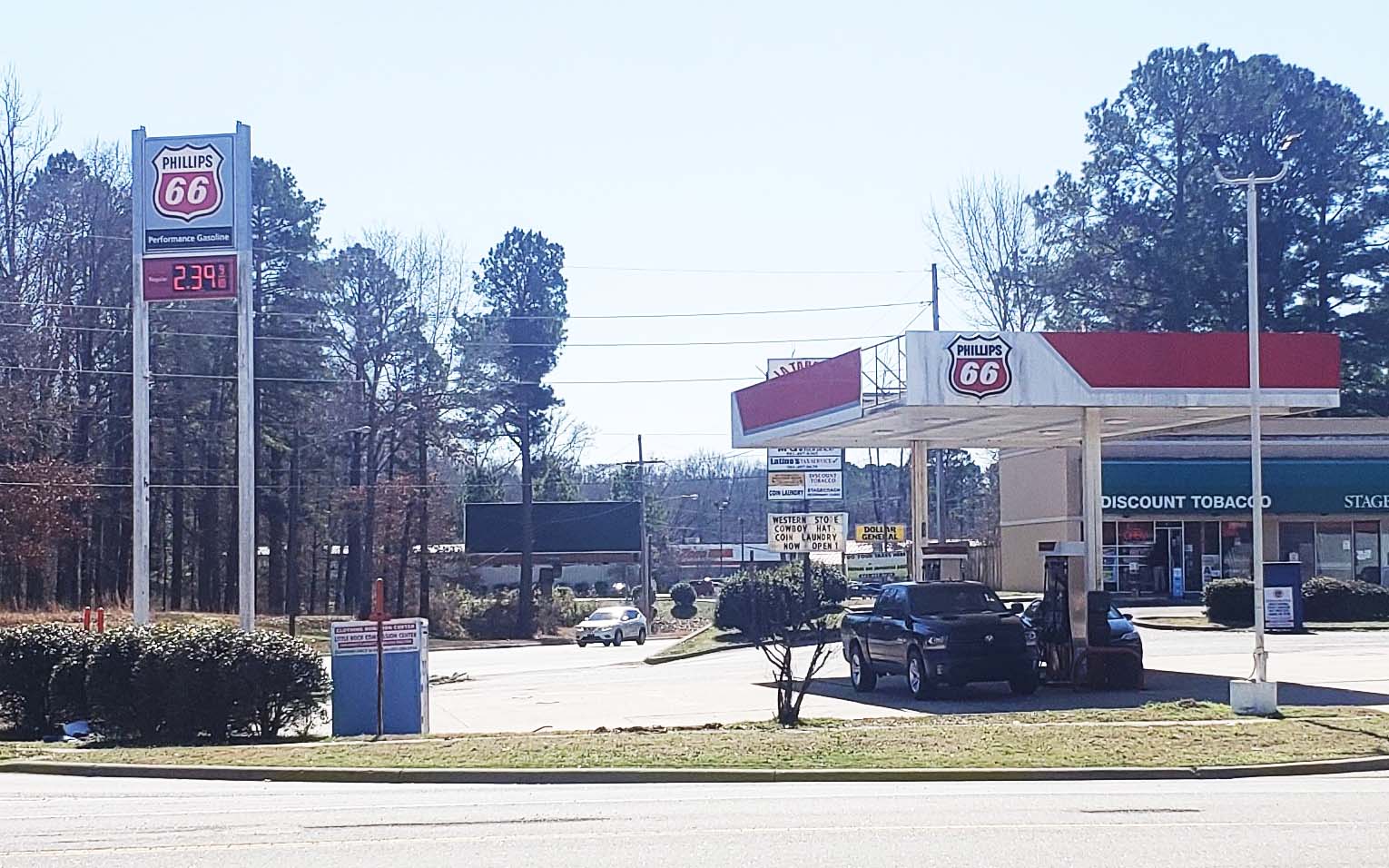Arkansas consumers jolted by higher gas prices, electric bills, and food costs
March 8-14, 2021
By Wesley Brown
Almost as quickly as the snow began to melt following the February winter storms, Arkansans are now trying to get over the shock of the recent spike in pump prices and energy bills as the spring nears.
At the same time, according to several closely watched economic reports, out-of-pocket consumer costs in February are well-above year ago levels and forecasted to continue climbing heading into the spring. Those higher prices for nearly all consumer goods are also raising fears that inflation will rise well above the Federal Reserve’s 2% annual target in 2021.
But at the basest level, Arkansas motorists are seeing some of the biggest spikes at the pump of all 50 states. According to AAA’s weekly “gas gauge” for all 50 states, Arkansas drivers are paying on average about $2.48 per gallon for regular unleaded. And although the Natural State traditionally sees some of the lowest gas prices in the nation, current costs to fill up a tank is 11 cents higher than last week and 30 cents higher than a month ago.
Nationally, the average gas price has gone up nine cents on the week to $2.72 per gallon. That is a 30-cent increase from the beginning of February, 28 cents more than a year ago and the most expensive daily national average since August 2019, said the former American Automobile Association.
The latest price jumps are a direct result of February’s winter storm that took 26 U.S. refineries offline and pushed refinery utilization from an average of about 83% down to a yearly low of 56%, according to the Energy Information Administration (EIA). Due to the shutdown of most Gulf Coast refineries following the Texas cold snap, U.S. crude stockpiles rose by 21.6 million barrels for the week ending Feb. 26 to 484.6 million barrels, the largest spike in the EIA series.
As of Feb. 2, AAA forecasts the national gas price average to hit at least $2.80 in March as gasoline production increased by 8.3 million barrels per day. For motorists, that means they can expect continued increases of at least 5–10 cents in local markets until refinery operations are stable.
“Barring hurricane season, March may bring the most expensive pump prices of 2021,” said Jeanette Casselano McGee, AAA spokesperson. “While the month is roaring in like a lion, by the end of it we could see some relief at the pump as refineries resume normal operations, especially if crude oil prices show signs of stability.”
* * * *
Refinery outages boost pump prices
Last week, refinery outages were reported in Texas, Louisiana, Oklahoma, Arkansas, Tennessee, and Kansas. One of the refineries that went offline on Feb. 27 was Delek Holding Inc.’s former Lion Oil complex in El Dorado, which has a crude producing capacity of 80,000 barrels per day. Delek said the refinery complex in South Arkansas caught fire over the last weekend in February, leading to six injuries. Company officials said the facility was in the process of undergoing turnaround activity but gave no date when operations would come by online.
In 2016, Delek sold off its Mapco retail stores in Arkansas and six other states to the Chile-based Copec, S.A. Delek. Besides the El Dorado refinery, the Israel-based oil refiner also operates several refined products terminals in Little Rock and nearly 250 company-owned convenience stores in central and west Texas and New Mexico.
While California ($3.68) and Hawaii ($3.46) started the year above the $3 per gallon mark, a few other states have followed or are close to following suit: Washington ($3.09), Nevada ($3.01), Arizona ($2.98), Pennsylvania ($2.95), Oregon ($2.95), Illinois ($2.89), Washington, D.C. ($2.88) and Alaska ($2.87).
Today, every state average is more expensive on the week and the month. Only three states have averages cheaper year-over-year: Hawaii (-10 cents), Alaska (-7 cents) and Oregon (-3 cents). Since last the winter storm blast left the state, Arkansas is still among the top ten states with the highest spike in gas prices.
These 10 states have seen the largest increases in their averages: Arizona (25 cents), Georgia (16 cents), New Mexico (15 cents), Texas (15 cents), Minnesota (15 cents), Arkansas (15 cents), Iowa (14 cents), Mississippi (14 cents), Oklahoma (14 cents) and Tennessee (13 cents).
At the same, Arkansas is still among the top 10 least expensive gasoline markets. Motorists in Mississippi, Louisiana and Texas are paying the lowest pump prices for regular unleaded at $2.38, $2.41, and $2.42 per gallon, respectively. Missouri, Alabama and Arkansas are next at $2.45, $2.46 and $2.47 per gallon, followed by South Carolina ($2.48), Oklahoma ($2.49), Montana and Tennessee ($2.50).
Meanwhile, pump prices in the state’s metropolitan areas range from a low of $2.41 in the Little Rock-North Little Rock to the highest recorded average of $2.51 at the Arkansas/Texas state line in Texarkana.
Drivers choosing to fill up the tanks with a higher-grade of gasoline should expect to pay an average premium of $3.08 a gallon across the state. Big rig drivers and other diesel fuel users will see pump prices at about $2.80 a gallon, up 27 cents from a year ago, according to AAA. The EIA, which is housed in the U.S. Energy Department, has forecast U.S. gas prices to average $2.71 per gallon in 2021 and $2.74 per gallon in 2022.
According to GasBuddy.com, drivers in some parts of Arkansas are seeing well below the U.S. and state average. For example, one station in Lake Village is offering the lowest prices in the state at $1.99 per gallon for regular unleaded.
* * * *
Inflation Fears
Still, AAA and the EIA’s prediction of high gasoline prices for the rest of the year coincides with two closely watch regional and national reports concerning the recent spike in prices for both consumer and wholesale goods. For Arkansas and several other Midwest states, the Creighton University’s Mid-America Business Conditions Index shows although the overall regional economy is improving, the wholesale inflation gauge soared to a record high.
As of March 1, the wholesale inflation gauge for the month for the nine-state region soared to 95.2, a record high and up from January’s 10-year high of 91.1. The Creighton University business index, which ranges between zero and 100, highlights several key economic indicators across a nine-state Midwest region that stretches from Arkansas to Minnesota.
“At the wholesale level, Creighton’s survey is tracking higher and higher inflationary pressures. Metal products and lumber, for example, are experiencing significant upward pressures in prices. Over the last six months metal prices have expanded by 11% and lumber products have advanced by 16% according to U.S. Bureau of Labor Statistics data,” said economist Ernie Goss, chair of Creighton University’s Heider College of Business. “Despite rapidly expanding inflationary pressures at the wholesale level, the Federal Reserve remains committed to its current expansionary policy.”
Closer to home, the Labor Department’s Bureau of Labor Statistics (BLS) monthly Consumer Price Index (CPI) reading also reported across-the-board spike in most consumer goods on Feb. 10. For example, the gasoline index continued to increase, rising 7.4% in January and accounting for most of the seasonally adjusted increase in all items index.
And although the indexes for electricity and natural gas declined, the energy index rose 3.5% over the month, BLS reported. Energy analysts also predict gasoline, electricity and natural gas indexes to see a substantially increase in the upcoming March report, which will include astronomical price spikes due to gas refinery shutdowns and energy grid snafus in Texas and other parts of the country that caused millions of Americans to lose power.
Overall, the CPI for all urban consumers across the U.S. rose 0.3% in January on a seasonally adjusted basis, BLS reported. reported today. Over the last 12 months, the “all items” index increased 1.4% before seasonal adjustment. The food index rose slightly in January, increasing 0.1% as an advance in the index for food away from home more than offset a decline in the index for food at home.
The index for all items less food and energy were unchanged in January. The readings for apparel, medical care, shelter, and motor vehicle insurance all increased over the month. The indexes for recreation, used cars and trucks, airline fares, and new vehicles all declined in January.
The all items index for the 12 months ending January rose 1.4%, the same increase for the period ending in December. The index for all items less food and energy also rose 1.4% over the last 12 months, a smaller increase than the 1.6% rise for the 12 months ending December. The all-important food index rose 3.8% over the last 12 months. In contrast to the recent spikes in gasoline and electricity prices, the energy index is down 3.6% for the year.
On Tuesday, New York Federal Reserve Governor Lael Brainard acknowledged that expressed concerns that high inflation could become a problem if the job market does not fully recovery over the long run. Brainard is the New York Fed representative on the influential Federal Open Market Committee, which sets the nation’s economic outlook and monetary policy.
“(Inflation) may curtail progress for racial and ethnic groups that have faced systemic challenges in the labor force,” said Brainard. “Instead, the shortfalls approach will enable the labor market to continue to improve absent clear indications of high inflationary pressures or an unmooring of inflation expectations to the upside.”
According to Brainard, the U.S. economy remains far from our goals in terms of both employment and inflation. She said it will take some time to achieve substantial further progress because the U.S. job market is still 10 million below the pre-COVID level, and inflation has been running below 2% for several years. The FOMC’s federal fund rates, the central interest rate for U.S. banks that influences longer-term financing terms for mortgages, loans and savings accounts, remains at zero percent.
“We will need to be patient to achieve the outcomes set out in our guidance,” said Brainard.
PHOTO CAPTIONS:
As Arkansans emerge from winter hibernations, costs for energy, consumer and wholesale goods are skyrocketing.






